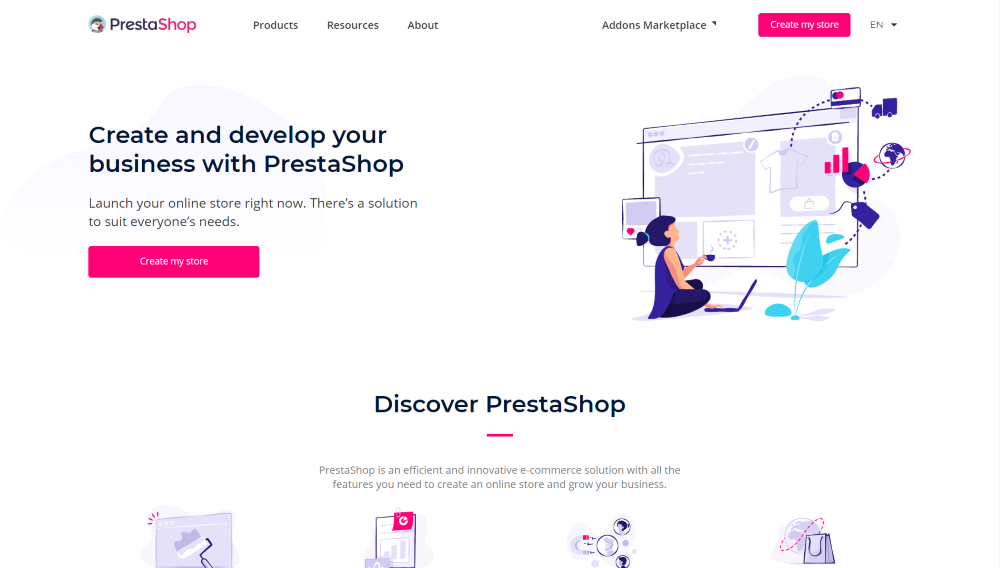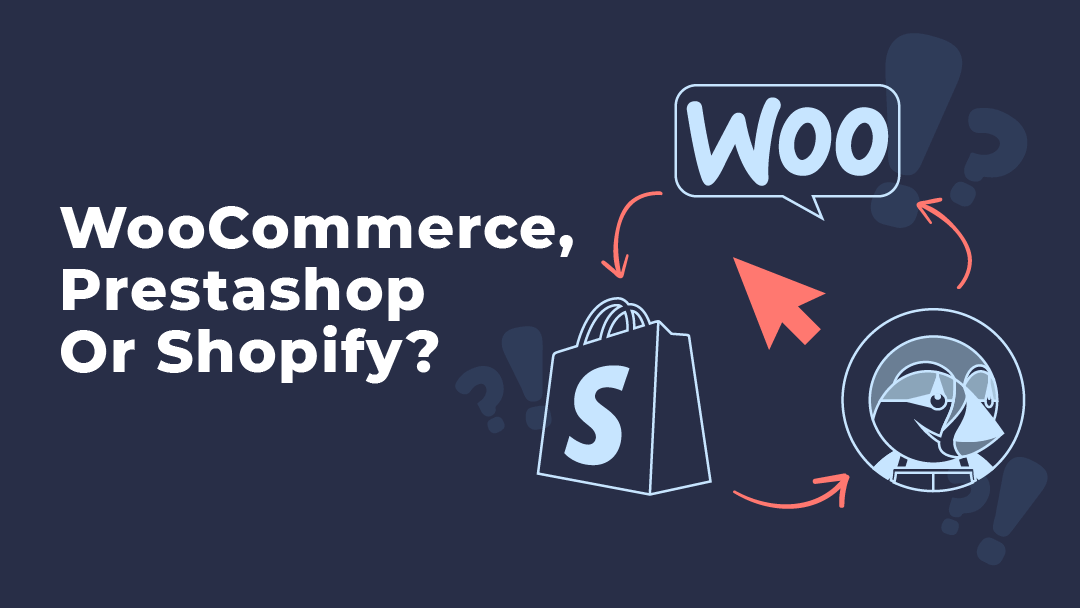When it comes to selecting a platform for eCommerce, there are lots of options to choose from. Some of the most popular options include WooCommerce, Prestashop, and Shopify. All three platforms have a lot to offer. In this article, we’ll take a look at the pros and cons of WooCommerce, Prestashop, and Shopify to help you decide which eCommerce platform is the best choice to build your online store.
What is WooCommerce?

WooCommerce is the most popular eCommerce plugin for WordPress. It launched in 2011 by WooThemes and is now owned by Automattic, the makers of WordPress, and integrates with your WordPress installation. WooCommerce powers millions of online stores and includes features to manage your sales, inventory, shipping, and more. List digital and physical products. It integrates with most of the popular payment gateways and allows you to manage inventory, shipping, taxes, and more. It’s WPML compatible, so you can make your store multilingual. Several widgets with multiple ways to display your products are included.
WooCommerce is free, but you can purchase add-ons to create an eCommerce platform with the exact features you want. It has hundreds of extensions to choose from. There are also lots of themes available including Divi child themes. WooCommerce works with any type of WordPress website and it can be added to an existing website. The mobile app makes it easy to manage your store on the go. It’s highly stable and has a massive global community. WooCommerce is ideal for small to medium shops and it can be scaled to any size at any time. It also includes lots of documentation for support.
WooCommerce Pros
- WooCommerce is free, so there are no upfront costs involved other than labor.
- Even though it has a lot of features, it’s easy to configure and use.
- You have complete control over your shop.
- WordPress and WooCommerce are popular, so there are lots of users, products, courses, communities, support, etc.
- It can be expanded with hundreds of add-ons.
- It’s highly compatible with WordPress themes and there are lots of themes that are designed specifically for WooCommerce.
- Divi excels at WooCommerce customizations. It includes lots of built-in modules and there are dozens of third-party Divi products designed specifically for WooCommerce.
- There are a lot of hosts to choose from and it works on any type of server or hosting plan.
- You can move to a different host if you want.
- It’s optimized for SEO and works great with Yoast.
WooCommerce Cons
- WooCommerce does have a lot of features to learn and set up the store can take time.
- It’s not a stand-alone platform, so you’ll need a WordPress website.
- You also have to learn WordPress. If you don’t already know how to use WordPress then you have to learn two platforms at the same time.
- WooCommerce isn’t a self-hosted system, so choosing a host can be difficult and time-consuming.
- Hosting, themes, add-ons, and maintenance can get expensive.
- There are a lot of things to manage, including hosting, backups, updates, security, etc. You have to manage everything yourself or pay someone to manage it for you.
- You’ll need to purchase add-ons to add some of the features that are native to other platforms, such as marketing and loyalty tools.
- It can be difficult to translate because of third-party add-ons.
- Most payment gateways are premium add-ons.
What is Prestashop?

PrestaShop is a highly customizable open-source platform that gives you complete control over your store. It was developed with PHP. There are around 6000 themes to choose from in the marketplace and you can modify them to fit your store’s branding. It requires separate hosting, but there are lots of good hosts to choose from and they do offer a pre-installed hosting solution. It supports all of the major payment gateways. It’s ideal for small to medium websites.
Sell physical and digital products, track inventory, use a multi-language product sheet, and create suppliers and manufacturers of products. It handles taxes, shipping costs, etc. You can even run multiple stores from a single interface. Create coupons, discounts, pricing rules, suggest products, etc. It also connects to social networks, creates customer groups, includes SEO tools, and lots more. Expand it even further with over 10,000 third-party modules and services. It also has a customer support plan, training courses, and more.
Prestashop Pros
- Prestashop is completely free.
- It’s open-source, so you can customize the code for your needs.
- It has a large community, so there’s a lot of help available.
- They have a hosted option, so you don’t have to handle the website if you don’t want to.
- The UI is intuitive.
- It doesn’t need a dedicated server, so shared hosting is fine.
- Your website is built around eCommerce, so all of the website elements are designed with eCommerce in mind.
- There are lots of free and premium templates to choose from.
- It’s affordable.
- It has SEO built-in.
- You can integrate it with ERPs.
- It does integrate with WordPress using third-party add-ons, so you can add it to your current website.
Prestashop Cons
- Even though they have hosting available, it’s through a separate hosting partner.
- It isn’t ideal for huge websites.
- It can be difficult to install and might require an expert to deal with technical issues.
- Complex product listings require extra programming.
- A lot of important features require you to purchase premium modules.
- It doesn’t allow for an extensive catalog.
- The multi-store and warehouse systems aren’t robust.
- The technical issues make it not ideal for beginners.
What is Shopify?

Shopify is a stand-alone storefront with a content management system that powers several large online retailers. It’s easy to make an online store quickly and without any technical knowledge or paying an expert to build it for you. You can change the design, upload products, manage the shop, accept payments, view orders, and more. It has over 70 paid and free themes and you can customize them with the drag-and-drop builder. It’s ideal for small stores and those without technical skills.
Shopify is subscription-based. There are several subscriptions to choose from, so you can pay for the exact features you want. Hosting is provided and includes SSL, unlimited bandwidth, 24/7 monitoring, updates, maintenance, security, and a domain name if you don’t have your own. List an unlimited number of products, sell physical and digital products, track stock, customize your cart, send emails for abandoned carts, set up flexible shipping rates, use Shopify Payments or choose from over 100 payment gateways, use drop-shipping, create customer groups, and more. It has built-in SEO, Google Analytics, a mobile app, etc. Expand your store with over 1000 integrations. 24/7 support is included.
Shopify Pros
- It’s easy to get started. Setup is fast and there are no technical skills required.
- It’s easy to use.
- Social media is integrated, making it easy to build your audience.
- You can change the look of your store with themes.
- There are lots of themes to choose from.
- Hosting is provided.
- You’re not responsible for backups, maintenance, security, updates, etc.
- Over 1000 apps are available to expand the functionality of your store.
- Dropshipping is simple.
- High-quality support is included.
Shopify Cons
- Shopify is a premium service with monthly payments.
- Prices will increase if you need more bandwidth and other features.
- Shopify’s credit rates vary depending on the subscription package.
- You don’t have access to the code, so you can’t expand the store beyond what Shopify and its apps provide.
- You have less control over the site.
- Customizations are limited.
- SEO isn’t as flexible as the other platforms.
- The server is in the United States, so users from other parts of the world might experience bottlenecks in bandwidth.
- Your store can only be hosted on Shopify’s servers, so you have no other control or options for hosting and you can’t move your store somewhere else.
Ending Thoughts
That’s our quick look at the pros and cons of WooCommerce, Prestashop, and Shopify, three of the most popular eCommerce platforms. All three are good choices for small businesses and for managing inventory. All three have advantages that are better suited to certain types of websites and users. The best way to know which you need is to plan your website so you’ll know what your needs are, and then compare those needs to your plan.
My personal favorite is WooCommerce. WooCommerce is a great choice if you want to start with a basic but powerful platform and don’t mind purchasing extensions to add the features you want. It’s scalable and integrates into your current WordPress website. Aspen Grove Studios has lots of plugins and Divi child themes for WooCommerce.
We want to hear from you. Have you tried WooCommerce, Prestashop, or Shopify? Tell us about your favorite eCommerce platform in the comments.


Recent Comments